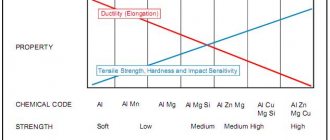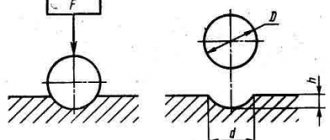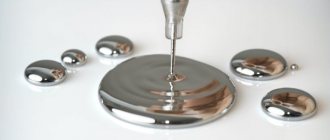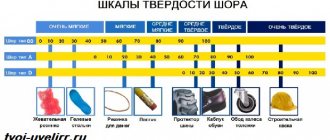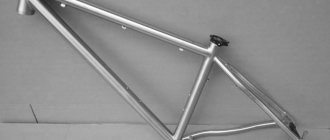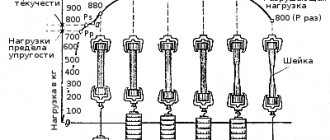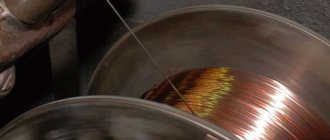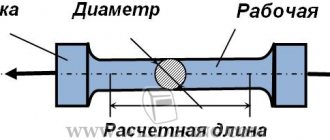Hardness concept
Hardness is a property of materials that characterizes the ability of one harder body to penetrate another. This characteristic also determines the resistance to plastic deformation or destruction of surface layers when applying strong pressure.
The indicator is measured in a variety of units depending on the method used.
All methods for determining the hardness of materials can be divided into several main groups:
- Static. Such methods are characterized by the fact that the load gradually increases. The holding time may vary - it all depends on the characteristics of the method used.
- Dynamic ones are characterized by the fact that the load on the sample is applied with a certain kinetic energy. In this case, the hardness indicator is less accurate, since under dynamic load a certain recoil occurs due to the elasticity of the material. The results of such tests are often referred to as the impact hardness of materials.
- Kinetic methods are based on continuous recording of indicators during testing, which makes it possible to obtain not only the final, but also an intermediate result. For this, special equipment is used.
Tool hardness measurement
In addition, the classification of methods for determining hardness is carried out according to the principle of applied load. The following methods of testing a sample are distinguished:
- Indentation is by far the most common way to determine the indicator in question.
- During rebound, a measurement is made of how high the firing pin flies from the surface of the test sample. In this case, the hardness calculation is carried out based on the resistance to elastic deformation. Methods of this type are quite often used to control the quality of rolling rollers and large-sized products.
- Methods based on scratching and cutting are used extremely rarely today. They were developed two centuries ago.
Typically, hardness testers have a part that affects the workpiece being tested. Examples include steel balls of various diameters and diamond tips with a pyramid shape. Let's take a closer look at some of the methods used today.
In what units is the hardness of a metal measured?
The peculiarity of this characteristic is that depending on the method by which the measurement was carried out, the classical designation also changes. Since the parameter cannot be classified among the main physical scales, such as distance, speed, mass, force, there is no single standard in the so-called SI system.
If the researcher uses one of the most standard methods proposed by Brinnell, which we will discuss in more detail below, then the result will be written in kgf/mm2, that is, in kilogram-force divided by square millimeter. Using the scale for measuring the hardness of metals, we can talk about classical examples and their indicators in relation to each other:
- iron alloys - on average 30 kgf/mm2;
- copper and nickel compositions – 10 kgf/mm2;
- aluminum, magnesium and their derivatives – 5 kgf/mm2.
So we conclude that iron is 6 times harder than the soft aluminum compound.
The second popular method was invented by Rockwell. According to it, one conditional value (cu) is equal to the displacement of the cone by 2 microns. If it is marked according to this option, then the indexing is first indicated, then one of three letters - A, B, C and a digital value. If you see the hardness of the HB material on the workpiece, then these are Rockwell units of measurement. Parts marked HR can also be marked with an index, and after 1 of three letters:
- A - indicates that the tests were carried out using a diamond cone with an apex angle of 120 degrees under an applied load of 50 - 60 kg.
- B - speaks of a ball of one-sixteenth of an inch, which is directed to the surface under a weight of 90 - 100 kg.
- C - a similar cone is used as with marking A, but the impact is increased at 140 - 150 kg.
Next comes a number that already indicates what kind of dent has formed.
And another option for how steel hardness is measured is numbers plus the letters HV. Vickers proposes this measurement. While using Shor’s method you can see the following records – 90 HSD.
Brinell hardness test
The most commonly used hardness measurement is Brinell. This method is regulated by GOST 9012. The features of testing metals and alloys using this method include the following points:
- A steel ball is used as a body that will exert an impact on the test sample.
- For testing, a ball with a certain diameter is used, which is made of hardened steel. A constantly increasing load is applied to it.
- The main condition for using this method of testing metals and alloys is that the ball must be made of a harder material than the test sample.
- After completion of the test, the resulting print is measured on the surface.
- This method allows you to obtain the data that is indicated in the HB. It is this designation that is found most often today in various reference documentation.
- For the convenience of using this method, special tables have been created, which are based on the dependence of the diametrical size of the ball, hardness and the resulting imprint.
Brinell measurement
It is worth considering that Brinell testing is not recommended for steels and alloys whose hardness exceeds 450HB. Non-ferrous metals must have a value below 200 HB.
In what units is the hardness of a metal measured?
The peculiarity of this characteristic is that depending on the method by which the measurement was carried out, the classical designation also changes. Since the parameter cannot be classified among the main physical scales, such as distance, speed, mass, force, there is no single standard in the so-called SI system.
If the researcher uses one of the most standard methods proposed by Brinnell, which we will discuss in more detail below, then the result will be written in kgf/mm2, that is, in kilogram-force divided by square millimeter. Using the scale for measuring the hardness of metals, we can talk about classical examples and their indicators in relation to each other:
- iron alloys - on average 30 kgf/mm2;
- copper and nickel compositions – 10 kgf/mm2;
- aluminum, magnesium and their derivatives – 5 kgf/mm2.
So we conclude that iron is 6 times harder than the soft aluminum compound.
The second popular method was invented by Rockwell. According to it, one conditional value (cu) is equal to the displacement of the cone by 2 microns. If it is marked according to this option, then the indexing is first indicated, then one of three letters - A, B, C and a digital value. If you see the hardness of the HB material on the workpiece, then these are Rockwell units of measurement. Parts marked HR can also be marked with an index, and after 1 of three letters:
- A - indicates that the tests were carried out using a diamond cone with an apex angle of 120 degrees under an applied load of 50 - 60 kg.
- B - speaks of a ball of one-sixteenth of an inch, which is directed to the surface under a weight of 90 - 100 kg.
- C - a similar cone is used as with marking A, but the impact is increased at 140 - 150 kg.
Next comes a number that already indicates what kind of dent has formed.
And another option for how steel hardness is measured is numbers plus the letters HV. Vickers proposes this measurement. While using Shor’s method you can see the following records – 90 HSD.
Vickers hardness measurement
There is also the Vickers hardness measurement method, which is regulated by GOST 2999. It has become widespread in determining the hardness of parts and workpieces that have a small thickness. In addition, it can be used to measure the hardness of parts with a surface hard layer.
The features of this method of testing a sample include the following points:
- The so-called diamond tip is used, which has the shape of a pyramid with four faces and equal sides.
- A specific holding time is selected.
- After the load is removed, the dimensions of the diagonals of the resulting print are measured and the arithmetic mean is calculated.
- The magnitude of the applied load is regulated and can be selected depending on the type of material being tested.
- The results obtained during the research are designated HV.
Vickers method
In some cases, after the obtained value, the holding time and the magnitude of the applied load are indicated, which makes it possible to determine the hardness value with greater accuracy.
How to determine the hardness of a metal: methods
There are many ways to measure it. To obtain the most accurate result, several methods are used at once. Let's take a closer look at them:
according to Brinell. This study involves pressing a special ball into the workpiece. After this, using the trace left on the iron, its mechanical coefficient is calculated using mathematical algorithms.
according to Rockwell. In this case, a ball or diamond cone is also used. The parameter is determined using calculations or displayed on a scale.
according to Vickers. This method is the most accurate and accurate measurement method. To conduct research, a pyramid-shaped tip made of diamond is used.
Rockwell hardness test
This method is regulated by GOST 9013. To carry it out, a special device is used for measuring hardness, which allows you to create two successive loads applied to the surface of the sample. Features of such a test include:
- First, a preload is applied, after which a second load is added.
- After holding under the total load for 3-5 seconds, the second one is removed, the depth of the indentation is measured, then the preliminary load is removed.
- The obtained data is measured in conventional units, which are equal to the axial displacement of the indicator by 0.002.
- The Rockwell hardness number is determined using a special scale of the device.
- The form of the indicator used may differ significantly. That is why several types of measuring scales have been introduced that correspond to a specific indicator shape.
- To designate the obtained value, the designations HIRA, HRC, HRB can be used. They correspond to the shape of the indicator and designation scale used.
Rockwell hardness measuring principle
A steel ball and two diamond cones of different sizes can be used as an indicator. This method of measuring the hardness of hardened parts is carried out only when using a smaller diamond cone, the preliminary applied load is 10 kgf, the main load is 50 kgf. Preloading eliminates the possibility that the elasticity of the material will cause the values obtained to be less accurate. In addition, preload allows you to measure the hardness of metals and alloys that have undergone preliminary heat treatment.
Methods for testing the mechanical properties of metals
The mechanical properties of metals (strength, elasticity, plasticity, toughness), as well as other properties, are the initial data in the design and creation of various machines, mechanisms and structures.
Methods for determining the mechanical properties of metals are divided into the following groups:
· static, when the load increases slowly and smoothly (tensile, compression, bending, torsion, hardness tests);
· dynamic, when the load increases at high speed (impact bending tests);
· cyclic, when the load changes many times (fatigue test);
· technological - to assess the behavior of metal during pressure treatment (bending, bending, extrusion tests).
Tensile tests (GOST 1497-84) are carried out on standard samples of round or rectangular cross-section. When stretched under the action of a gradually increasing load, the sample is deformed until it breaks. During testing of the sample, a tensile diagram is taken (Fig. 1.36, a), which records the relationship between the force P acting on the sample and the deformation Δl caused by it (Δl is the absolute elongation).
Rice. 1.36. Tensile diagram of mild steel (a) and relationship between stress and elongation (b)
Viscosity (internal friction) is the ability of a metal to absorb the energy of external forces during plastic deformation and fracture (determined by the magnitude of the tangential force applied per unit area of the metal layer subject to shear).
Plasticity is the ability of solids to deform irreversibly under the influence of external forces.
The tensile test determines:
· σв — strength limit, MN/m2 (kg/mm2):
where Pb is the greatest load; F0 is the initial cross-sectional area of the sample;
· σпц — proportionality limit, MN/m2 (kg/mm2):
where Ppc is the load corresponding to the proportionality limit;
· σpr — elastic limit, MN/m2 (kg/mm2):
where Rpr is the load corresponding to the elastic limit (at σpr the residual deformation corresponds to 0.05-0.005% of the initial length);
· σт—yield limit, MN/m2 (kg/mm2):
where Рт is the load corresponding to the yield point, N;
· δ—relative elongation, %:
where l0 is the length of the sample before rupture, m; l1 is the length of the sample after rupture, m;
· ψ — relative narrowing, %:
where F0 is the cross-sectional area before the rupture, m2; F—sectional area after rupture, m2.
Hardness tests
Hardness is the resistance of a material to the penetration of another, harder body. Of all types of mechanical testing, hardness determination is the most common.
Brinell tests (GOST 9012-83) are carried out by pressing a steel ball into the metal. As a result, a spherical imprint is formed on the metal surface (Fig. 1.37, a).
Brinell hardness is determined by the formula:
where P is the load on the metal, N; D—ball diameter, m; d—imprint diameter, m.
The harder the metal, the smaller the print area.
The diameter of the ball and the load are set depending on the metal being tested, its hardness and thickness. When testing steel and cast iron, choose D = 10 mm and P = 30 kN (3000 kgf), when testing copper and its alloys, D = 10 mm and P = 10 kN (1000 kgf), and when testing very soft metals (aluminum, babbitt etc.) D = 10 mm and P = 2.5 kN (250 kgf). When testing samples with a thickness of less than 6 mm, balls with a smaller diameter are selected - 5 and 2.5 mm. In practice, they use a table for converting the area of the imprint into the hardness number.
The Brinell method is not recommended for metals with a hardness of more than HB 450 (4500 MPa), since the ball may be deformed, which will distort the test results.
Rockwell tests (GOST 9013-83). They are carried out by pressing a diamond cone (α = 120°) or a steel ball (D = 1.588 mm or 1/16″) into the metal, Fig. 1.37, b. The Rockwell instrument has three scales - B, C and A. The diamond cone is used to test hard materials (scales C and A), and the ball is used to test soft materials (scale B). The cone and ball are pressed under two successive loads: preliminary P0 and general P:
P = P0 + P1,
where P1 is the main load.
Pre-load P0 = 100 N (10 kgf). The main load is 900 N (90 kgf) for scale B; 1400 N (140 kgf) for scale C and 500 N (50 kgf) for scale A.
Rice. 1.37. Scheme for determining hardness: a - according to Brinell; b - according to Rockwell; c - according to Vickers
Rockwell hardness is measured in arbitrary units. The unit of hardness is taken to be the value that corresponds to the axial movement of the tip over a distance of 0.002 mm.
Rockwell hardness is calculated as follows:
HR = 100 – e (scales A and C); HR = 130 – e (scale B).
The value of e is determined by the formula:
,
where h is the depth of penetration of the tip into the metal under the influence of the total load P (P = P0+ P1); h0 is the penetration depth of the tip under the influence of preload P0.
Depending on the scale, Rockwell hardness is designated HRB, HRC, HRA.
Vickers tests (GOST 2999-83). The method is based on pressing a tetrahedral diamond pyramid (α = 136°) into the test surface (ground or even polished) (Fig. 1.37, c). The method is used to determine the hardness of thin parts and thin surface layers with high hardness.
Vickers hardness:
where P is the load on the pyramid, N; d is the arithmetic mean of two imprint diagonals measured after removing the load, m.
The Vickers hardness number is determined using special tables along the diagonal of the indentation d. When measuring hardness, a load from 10 to 500 N is used.
Microhardness (GOST 9450-84). The principle of determining microhardness is the same as that of Vickers, according to the relationship:
The method is used to determine the microhardness of small-sized products and individual components of alloys. The device for measuring microhardness is a diamond pyramid indentation mechanism and a metallographic microscope. Samples for measurements must be prepared as carefully as microsections.
Impact test
For impact testing, special samples with a notch are made, which are then destroyed on a pendulum impact driver (Fig. 1.39). The total energy reserve of the pendulum will be spent on the destruction of the sample and on raising the pendulum after its destruction. Therefore, if we subtract from the total energy reserve of the pendulum the part that is spent on lifting (takeoff) after the destruction of the sample, we obtain the work of destruction of the sample:
K = Р(h1 – h2)
or
K = Pl(cos β – cos α), J (kg m),
where P is the mass of the pendulum, N (kg); h1 is the height of the pendulum’s center of mass before impact, m; h2 is the take-off height of the pendulum after impact, m; l is the length of the pendulum, m; α, β are the angles of elevation of the pendulum, respectively, before and after the destruction of the sample.
Rice. 1.39. Impact test: 1 - pendulum; 2 — pendulum knife; 3 - supports
Impact strength, i.e., the work expended on the destruction of the sample and related to the cross-section of the sample at the site of the notch, is determined by the formula:
, MJ/m2 (kg m/cm2),
where F is the cross-sectional area at the site of the sample cut, m2 (cm2).
To determine KС, special tables are used, in which the magnitude of the impact work K is determined for each angle β. In this case, F = 0.8 10–4 m2.
To indicate impact strength, a third letter is added, indicating the type of cut on the sample: U, V, T. The notation KСU means the impact strength of a sample with a U-shaped notch, KСV - with a V-shaped notch, and KST - with a crack (Fig. 1.40).
Rice. 1.40. Types of cuts on samples for impact strength testing: a - U-shaped cut (KCU); b — V-shaped incision (KСV); c - cut with a crack (KST)
Fatigue test (GOST 2860-84). The destruction of metal under the influence of repeated or alternating stresses is called metal fatigue. When a metal fractures due to fatigue in air, the fracture consists of two zones: the first zone has a smooth ground-in surface (fatigue zone), the second is a fracture zone; in brittle metals it has a coarse-crystalline structure, and in viscous metals it has a fibrous structure.
When testing for fatigue, the limit of fatigue (endurance) is determined, i.e., the greatest stress that a metal (specimen) can withstand without destruction for a given number of cycles. The most common fatigue test method is the rotational bending test (Figure 1.41).
Rice. 1.41. Scheme of rotational bending test: 1 - sample; P—load; Mbg - bending moment
The following main types of technological tests (samples) are used.
Bending test (Fig. 1.42) in a cold and hot state - to determine the ability of the metal to withstand a given bend; sample dimensions - length l = 5a + 150 mm, width b = 2a (but not less than 10 mm), where a is the thickness of the material.
Rice. 1.42. Technological bending test: a - sample before testing; b - bend to a certain angle; c - bend until the sides are parallel; g - bend until the sides touch
The bend test involves assessing the ability of a metal to withstand repeated bending and is used for wire and rods with a diameter of 0.8–7 mm from strip and sheet material up to 55 mm thick. The samples are bent alternately to the right and to the left by 90° at a uniform speed of about 60 bends per minute until the sample is destroyed.
Extrusion test (Fig. 1.43) - to determine the ability of the metal to cold stamping and drawing thin sheet material. It consists of pressing a sheet of material with a punch, sandwiched between a matrix and a clamp. A characteristic of the plasticity of the metal is the depth of extrusion of the hole, which corresponds to the appearance of the first crack.
Rice. 1.43. Extrusion test: 1 - sheet; h is a measure of the material’s ability to draw
Test for winding wire with diameter d ≤ 6 mm. The test consists of winding 5-6 tightly fitting turns along a helical line onto a cylinder of a given diameter. Performed only in a cold state. The wire after coiling should not be damaged.
The spark test is used when it is necessary to determine the grade of steel in the absence of special equipment and markings.
Shore hardness measurement
The Shore hardness method is used to test rolling rollers at the time of manufacture. In addition, checking the indicator under consideration can be carried out during the operation of rollers on rolling machines, since due to the impact, the structure of the metal can change, deteriorating performance. The Shore method is regulated by GOST 23273.
Shore hardness scale
When considering Shore hardness measurement, the following points should be noted:
- Unlike previous methods, this one is based on the free fall of a diamond indicator onto the test surface from a certain height. For testing, special equipment is used that allows you to accurately record the height of the rebound.
- The weight of the diamond-tipped striker used is 36 grams. This indicator is important as it is taken into account in the calculations.
- Hardness is determined by the height of the rebound, the measurement is carried out in conventional units. The sample falls onto the surface with the formation of a small depression, and elasticity leads to rebound. This method is good because it allows testing samples that have undergone preliminary heat treatment. When applied gradually, the resulting load may cause deformation of the tip or ball being used. In this case, the likelihood of their deformation is very small.
- In this case, 100 units of hardness is considered to be a rebound height of 13.6 mm with the possibility of a slight deviation up or down. This indicator can be obtained by testing carbon steel that has undergone a hardening process. The abbreviation HSD is used as a designation.
Today, this method of measuring hardness is used quite rarely due to the high error and complexity of measuring the height of the bike’s rebound from the test surface.
As previously noted, there are quite a large number of methods for measuring the indicator in question. However, due to the complexity of the tests and the large error, many are no longer used.
In some cases, microhardness testing is carried out. To measure this indicator, a static load is applied to a pyramid-shaped body, and it enters the test sample. The exposure time can vary over a wide range. The indicator is calculated in approximately the same way as with the Vickers method.
Hardness of metals
The hardness of metals is the most thoroughly studied and internationally standardized hardness measurement. The most common methods are:
Measuring the hardness of metals according to Brinell (hardness testers)
One of the oldest methods, hardness is determined by the diameter of the impression left by a metal ball pressed into the surface. Denoted by HB, where H is Hardness, B is Brinell.
Measuring the hardness of metals according to Rockwell (hardness testers)
This is the most common method of the early 20th century; hardness is determined by the relative depth of indentation of a metal ball or diamond cone into the surface of the material being tested. It is designated HR, where H is Hardness, R is Rockwell, and the 3rd letter indicates the type of scale, for example. HRA, HRB, HRC, etc.
Measuring the hardness of metals according to Vickers (hardness testers and microhardness testers)
The widest scale in terms of coverage, hardness is determined by the area of the imprint left by a tetrahedral diamond pyramid pressed into the surface. It is designated HV, where H is Hardness, V is Vickers.
Measuring the hardness of metals according to Shore (hardness testers and scleroscopes)
This method is extremely rarely used; hardness is determined by the height of the striker’s rebound from the surface. It is designated HS, where H is Hardness, S is Shore, and the 3rd letter indicates the type of scale, for example. HSD
Measuring the hardness of metals according to Lieb (hardness testers)
This is the most widely used method in the world today, hardness is defined as the ratio of the velocities before and after the striker rebounds from the surface. It is designated HL, where H is Hardness, L is Leeb, and the 3rd letter indicates the type of sensor, for example. HLD, HLC, etc.
Hardness value ratio
When choosing a method for measuring surface hardness, it should be taken into account that there is no relationship between the data obtained. In other words, it is impossible to accurately convert one unit of measurement to another. The dependence tables used do not have a physical meaning, since they are empirical. The lack of dependence can also be attributed to the fact that different loads and different tip shapes are used during testing.
The existing tables should be used with great caution as they only provide approximate results. In some cases, the translation in question may turn out to be very accurate, which is due to the similar physical and mechanical properties of the metals being tested.
In conclusion, we note that the value of hardness is related to many other mechanical properties, for example, strength, elasticity and ductility. Therefore, to determine the basic properties of a metal, hardness is often measured. However, there is no direct relationship between all the mechanical properties of metals and alloys, which should be taken into account when carrying out measurements.
Hardness of base metals and alloys
The hardness value is measured on finished parts sent for assembly. Control is carried out for compliance with the drawing and technological process. Tables of hardness values have already been compiled for all basic materials, both in the initial state and after heat treatment.
Non-ferrous metals
The Brinell hardness of copper is 35 HB, the values of brass are 42-60 HB units, depending on its brand. For aluminum, the hardness is in the range of 15-20 HB, and for duralumin it is already 70 HB.
Black metals
The Rockwell hardness of cast iron SCH20 HRC 22, which corresponds to 220 HB. Steel: tool – 640-700 HB, stainless steel – 250 HB.
To convert from one measurement system to another, tables are used. The values in them are not true, because they are derived imperially. Not the full volume is presented in the table.
| HB | H.V. | H.R.C. | HRA | HSD |
| 228 | 240 | 20 | 60.7 | 36 |
| 260 | 275 | 24 | 62.5 | 40 |
| 280 | 295 | 29 | 65 | 44 |
| 320 | 340 | 34.5 | 67.5 | 49 |
| 360 | 380 | 39 | 70 | 54 |
| 415 | 440 | 44.5 | 73 | 61 |
| 450 | 480 | 47 | 74.5 | 64 |
| 480 | 520 | 50 | 76 | 68 |
| 500 | 540 | 52 | 77 | 73 |
| 535 | 580 | 54 | 78 | 78 |
Hardness values, even if produced by the same method, depend on the applied load. The lower the load, the higher the readings.
